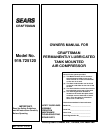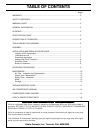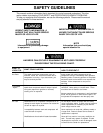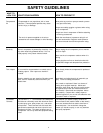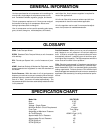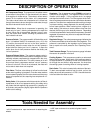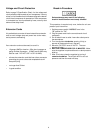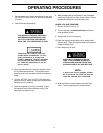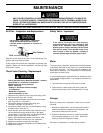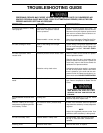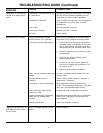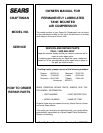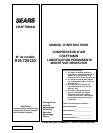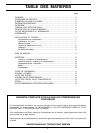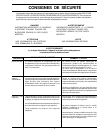
6
Air Compressor Pump: To compress air, the piston moves
up and down in the cylinder. On the downstroke, air is drawn
in through the air intake valves. The exhaust valves remain
closed. On the upstroke of the piston, air is compressed.
The intake valves close and compressed air is forced out
through the exhaust valves, through the outlet tube, through
the check valve and into the air tank.
Check Valve: When the air compressor is operating, the
check valve is “open”, allowing compressed air to enter the
air tank. When the air compressor reaches “cut-out” pres-
sure, the check valve “closes”, allowing air pressure to re-
main inside the air tank.
Pressure Switch: The pressure switch is fitted with a small
lever. It is labeled "Auto/O" for automatic run or off. In the
"O" position, the motor will not run. In the "Auto" position, it
automatically starts the motor when the air tank pressure
drops below the factory set “cut-in” pressure. It stops the
motor when the air tank pressure reaches the factory set
“cut-out” pressure.
Pressure Release Valve: The pressure release valve lo-
cated on the side of the pressure switch is designed to auto-
matically release compressed air trapped within the com-
pressor head and outlet tube. This short release of air will
occur when the air compressor reaches "cut-out" pressure
or the unit is shut off. If the air is not released, the motor will
not be able to start when next required.
Flow Valve: The flow valve allows air to flow from the head
as the motor is getting “up to speed”. Once the motor reaches
normal operating speed, the flow valve closes and the pump
begins to compress air, thus requiring less amp draw on ini-
tial start.
Safety Valve: If the pressure switch does not shut off the air
compressor at its cut-out pressure setting, the safety valve
will protect the tank against high pressure by “popping out”
at its factory set pressure (slightly higher than the pressure
switch cut-out setting).
Tools Needed for Assembly
• a 9/16" socket and an open end wrench for attaching the
wheels
• a 3/8" open end wrench or socket to tighten handle
screws
Regulator: The air pressure coming FROM the air tank is
controlled by the regulator. The regulator control knob is a
vibration proof design. Lift the regulator knob to engage
and depress the knob to lock. Turn the regulator knob clock-
wise to increase pressure and counter-clockwise to decrease
pressure. To avoid minor readjustment after making a change
in pressure setting, always approach the desired pressure
from a lower pressure. When reducing from a higher to a
lower setting, first reduce to some pressure less than that
desired, then bring up to the desired pressure. Depending
on the air requirements of each particular accessory, the outlet
regulated air pressure may have to be adjusted while oper-
ating the accessory.
Regulator Gauge: The outlet pressure gauge indicates the
air pressure available at the outlet side of the regulator. This
pressure is controlled by the regulator and is always less
than or equal to the tank pressure. See “Operating Proce-
dures”.
Tank Pressure Gauge: The tank pressure gauge indicates
the reserve air pressure in the tank.
Cooling System: This compressor contains an advanced
design cooling system. At the heart of this cooling system is
an engineered fan. It is perfectly normal for this fan to blow
air through the vent holes in large amounts. You know that
the cooling system is working when air is being expelled.
Drain Valve: This valve is located at the bottom of the tank.
To drain accumulated moisture from the tank, pull on the
safety valve until tank pressure is 15 PSI. Unscrew the drain
valve and allow the water to drain.
DESCRIPTION OF OPERATION



